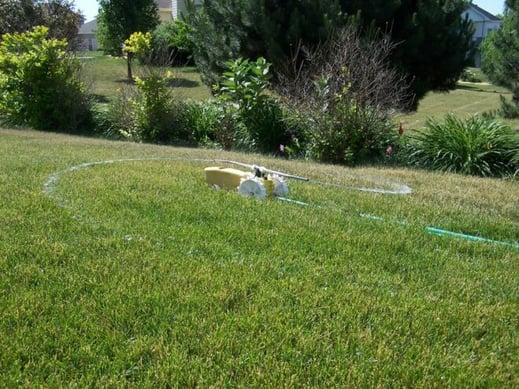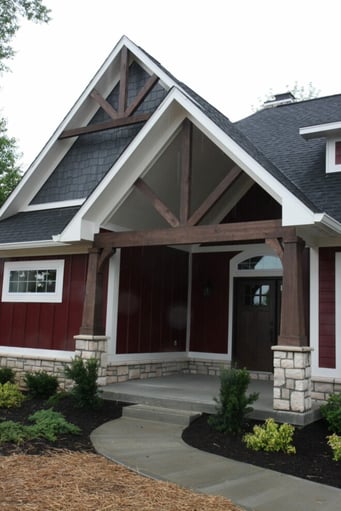One of the most frequent questions we receive from customers in the first few months of owning their new home is when they can expect their lawns to really take off and look nice. Many of our homeowners come from homes with lush, green grass and are not used to seeing a lawn in it’s infancy and toddler stages. The truth is that a well-established lawn just takes proper maintenance, time, and patience. And a little help from Mother Nature…and sprinklers!

© Rab520 | Dreamstime Stock Photos & Stock Free Images
Our Construction Manager, Kyle Kibler, worked with a landscape company prior to starting with Joyner Homes. Here he shares his thoughts about how to get your lawn off to a great start!

The first and most important part of establishing your new lawn is helping the seed to germinate. Once the nighttime temperatures are above 50 degrees, begin keeping the soil saturated with water using irrigation or sprinklers. This should be maintained until the seed has sprouted and filled in enough to really need mowed. Then, continue regular watering for the following 2-3 weeks and/or when the conditions are hot and dry.
HERE’S WHAT TO DO:
Set up a means to water your yard. If you do not have an irrigation system we recommend purchasing timers (that hook to your hose bibs), cheap hoses, and cheap sprinkler heads. If you have larger lawn (1+ acres), just focus on the area around the house.
The seed will sit dormant in the soil until it has moisture. Once moisture is present the seed will begin to germinate. Once you manually begin watering or after the first rain, you’ll need to continue an ongoing watering program or the new sprouts will die.
During germination, keep the top ¼” of the soil moist at all times. It can take 1-4 weeks to see sprouting depending on the seed mixture. The first sprouts of grass you’ll see coming up is usually an annual rye grass with a courser appearance. This grass comes up early and is there to serve as a temporary cover for the bluegrass or fescue that typically takes 14-21 days to germinate. The rye grass will eventually die out over time as the blue grass and fescue fill in.
Once the sprouts appear, keep the top ½” of the soil moist, seed will continue to germinate for another 3-6 weeks and your yard will begin to fill in. Seed that has just germinated and is left to dry out DOES NOT RECOVER. In the summer it is best to water in short intervals 2-3 times per day.
After 4-6 weeks you can begin a fertilizer application program. Don’t apply anything with a pre-emergent, herbicide (i.e. weed control), or insecticide (i.e. grub control) at this point (the seeds won’t continue to germinate).
Continue watering regularly for 2-3 weeks after the first mowing has taken place. At this point, you can reduce the amount of watering. Still do not let your soil dry for more than 2 to 3 days. The goal is to get your lawn as healthy as you can by fall. Apply seasonally appropriate fertilizer approx. every 6 weeks. NOTE: We recommend hiring a lawn care company for weed and fertilization treatment. They’ll put you on a good routine!
HERE’S WHAT TO EXPECT:
In your first year you will have a lot of weeds in your yard. A pre-emergent (that kills weeds in the seed before they sprout) cannot be applied on a new lawn because it will kill the grass seeds as well as the weeds. Don’t worry! Almost all of the weeds will die in the winter and you can apply a pre-emergent in the spring. If you have mowed your yard at least 5-6 times and it is well established, you can apply a grass friendly weed killer in the fall. The lawn will be patchy for the first year or so. If you have any bare spots in your yard, seed them around the first 2 weeks in August, then water per instructions above.
Grass grows best in the spring and fall. Regularly fertilize and continue to water thru the second growing season of your new lawn. If you do that, your yard should be full and lush just before winter. It’s best to continue the watering during the second summer to keep the new lawn healthy and allow it to completely fill in. For those large yards that can’t possibly be watered, a combination of fertilization, slice seeding, and aeration will help your lawn get established.
A good rule of thumb that we share with our homeowners is that a new lawn typically takes about 3 growing seasons (Fall-Spring-Fall or Spring-Fall-Spring) to start looking full and established. Once it is going and established though, there is nothing better than admiring a beautiful lawn from your new front porch!

If you have any questions about your new lawn, or anything else home related, let us know!
YOU MIGHT ALSO LIKE
CATEGORIES
- completed homes (43)
- faq (22)
- custom homes (20)
- build on your lot (16)
- homeowner tips (16)
- jh communities (16)
- the bedford (8)
- design-build (6)
- homes for sale (6)
- jh black (6)
- the nantucket (4)
- the rockford (4)
- jh team (3)
- the aspen (3)
- the dakota (3)
- the denali (3)
- the juniper (3)
- design studio (2)
- low-maintenance (2)
- the addison (2)
- the camden (2)
- the cypress (2)
- the flatrock (2)
- dakota (1)